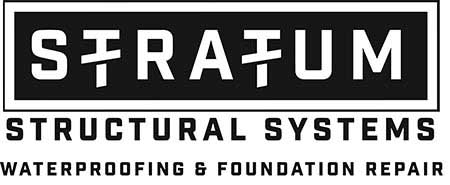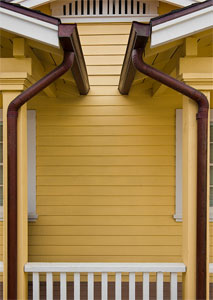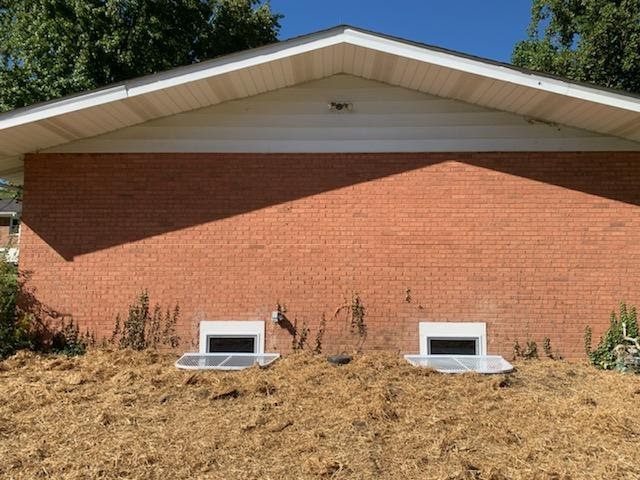Solutions for Repairing Bowing Walls

Bowing walls are a frequent issue for homeowners in St. Louis County. The region’s clay-rich soils and fluctuating moisture levels can create significant pressure on foundation walls that can lead to bowing. If left unaddressed, bowing walls can result in more severe issues, such as water infiltration, mold growth, and even total foundation failure. Fortunately, there are several effective ways to repair bowing walls in St. Louis and restore the structural integrity of your home. Here are the most common methods for bowing wall repair in St. Louis County!
Carbon Fiber Straps
Carbon fiber straps are a modern and effective solution for reinforcing bowing walls, particularly those that are bowing 2 inches or less. Made from high-strength carbon fibers, these straps are incredibly durable and lightweight. They are designed to provide additional support to foundation walls that have begun to bow or crack due to external pressure from soil or water.
The primary advantage of carbon fiber straps is their ability to reinforce walls without the need for extensive excavation or intrusive construction work, making them a minimally invasive option.
To install carbon filter straps to the wall, you must use a high-strength epoxy resin to bond the strap to the wall. To seal existing cracks, an epoxy or urethane injection will prevent further water infiltration and damage.
Once applied, the straps act like a brace. The carbon fiber straps ensure that the external pressure spreads more evenly across the wall, significantly enhancing its structural integrity.
Carbon fiber straps are often the least expensive option available for addressing minor bowing, offering St. Louis homeowners a cost-effective and efficient solution to maintain structural integrity.
Dead Man Wall Anchors
Wall anchors are a crucial solution for addressing bowing walls, particularly when the bowing exceeds 2 inches. These anchors work by relieving the pressure exerted on the foundation wall and redistributing it into the surrounding soil on the exterior or the surrounding wall surface at the interior.
This method involves placing anchors in a trench outside the home and connecting them to the interior wall using high-strength steel rods. The rods are tightened to pull the wall back into alignment, effectively stabilizing it.
Choosing wall anchors over other methods depends on several factors, including the severity of the wall’s bowing and the available space outside the foundation. Wall anchors are ideal for more severely bowed walls.
They require at least 10 feet of accessible ground outside the basement for installation. Adding wall anchors is a permanent and minimally invasive solution. It can stabilize the wall immediately or over time, depending on the extent of excavation required.
However, some property layouts don’t allow for anchor installation. These instances include obstacles like internal or external utilities and appliances, porches or property lines. In these moments, alternative methods like helical tiebacks may be necessary.
Additionally, due to the potential for leakage of the post repair core hole, an external excavation is usually an important consideration.
Helical Tieback Wall Anchors
Helical tiebacks are a type of foundation stabilization device used to provide lateral support to structures like basements and retaining walls. They are particularly effective when significant reinforcement is needed, such as when walls are bowing more than two inches.
Helical tiebacks consist of a steel shaft with helical blades resembling a large screw. To secure the property, the helical tieback gets drilled at an angle into the ground. This installation transfers the load from the wall to the soil, counteracting the lateral forces exerted by soil and water pressure.
Unlike dead man wall anchors, helical tiebacks sometimes don’t require extensive excavation. They’re installed from inside the basement, making this option a suitable choice for properties where exterior access is limited, or excavation is not feasible. However, the 2” bow guideline needs to be adhered to.
While helical tiebacks are the most expensive option, they offer robust and immediate stabilization, making them ideal for severe cases of wall bowing or leaning. Additionally, they can be installed in various soil conditions and are resistant to corrosion, providing a long-term solution to foundation instability.
Additionally, due to the potential for leakage of the post repair core hole, an external excavation is usually an important consideration.
Steel I-Beams or H-Beams
Steel I-beams and H-beams are installed vertically against a wall to counteract the lateral pressure exerted by soil or water, which causes the wall to bow. The choice between I-beams and H-beams depends on specific structural needs and site conditions.
I-beams are characterized by their “I” shape. They are made from a single piece of steel and are known for their ability to resist bending due to their tapered flanges.
I-beams are often used in applications where lighter weight and flexibility are required. These requirements make I-beams suitable for typical commercial buildings and residential projects.
H-beams, on the other hand, have a wider flange and thicker web. These attributes provide greater strength and load-bearing capacity.
These support mechanisms are particularly effective in cases that require support over longer spans or where heavier loads are present. This criteria makes H-beams a practical choice for projects such as bridges or large industrial structures.
H-beams are generally more efficient at carrying bending and shear loads, making them a preferred choice when significant reinforcement is needed. The decision to use steel beams, whether I-beams or H-beams, is often made when wall anchors are not feasible due to space constraints or when the wall’s bowing is too severe for other methods like carbon fiber straps.
Epoxy/Urethane Crack Injection
Epoxy crack injection is a technique used to repair cracks in concrete walls, particularly those that accompany bowing walls. The process typically involves installing injection ports along the crack, sealing the surface with an epoxy adhesive, and then injecting the epoxy into the crack under low pressure.
The epoxy acts as a bonding agent, filling the crack and restoring some of the wall’s structural integrity. It’s particularly effective for filling cracks that range from 0.002 to 1 inch wide in walls up to 12 inches thick.
Epoxy crack injection is a suitable option when the primary concern is sealing cracks to prevent water leaks and improve the wall’s stability. However, it’s important to note that this method is most effective for dormant cracks, as active cracks may reappear if the underlying cause of the movement is not addressed.
This technique is often used in tandem with other reinforcement methods, such as carbon fiber straps, to stabilize and reinforce the wall further. Compared to other options like wall anchors or helical tiebacks, epoxy injection is less invasive and can be a cost-effective solution for minor crack repairs. However, for walls experiencing significant movement or bowing, additional structural reinforcement may be necessary to ensure long-term stability
Which Fix for Bowing Walls Is Right for My St. Louis Home?
When considering how to fix bowing walls in your St. Louis home, it’s important to weigh the pros and cons of each method. Carbon fiber straps are a cost-effective and minimally invasive option for walls bowing less than two inches, offering a quick installation process and a discreet finish. Wall anchors provide a robust solution for more severe bowing by redistributing pressure into the surrounding soil, but they require sufficient exterior space for installation.
Helical tiebacks are ideal for significant reinforcement needs, though they tend to be more expensive. Steel I-beams offer strong support without the need for excavation, making them a good choice when wall anchors aren’t feasible. Epoxy crack injection is best for sealing cracks and preventing water intrusion but is often used in conjunction with other methods for comprehensive repair.
Given the complexity of diagnosing and repairing bowing walls, professional help is crucial to ensure the most effective and safe solution. At Stratum Structural Systems, we understand the unique challenges posed by St. Louis’s clay-rich soils and fluctuating moisture levels. Our experienced team is dedicated to providing the most reliable and efficient solutions tailored to your home’s specific needs. Trust our expertise to restore the integrity of your foundation and safeguard your home for the future. Contact us today!




